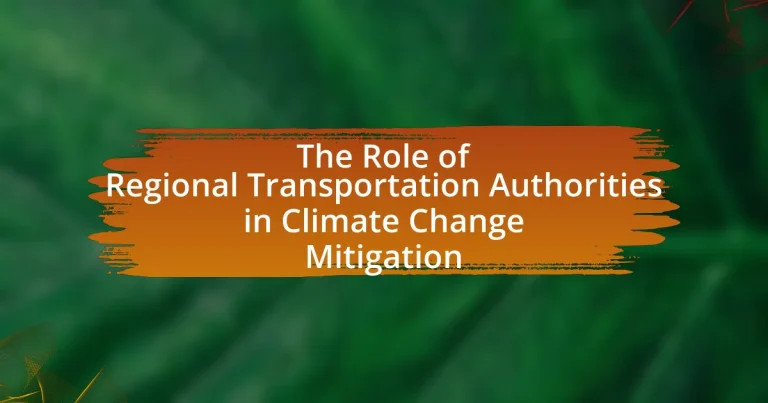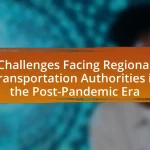Regional Transportation Authorities (RTAs) are pivotal in mitigating climate change through the development of sustainable transportation systems that significantly reduce greenhouse gas emissions. They achieve this by promoting public transit, enhancing active transportation options like biking and walking, and integrating land use planning with transportation strategies. The article explores how RTAs contribute to emission reductions, the specific strategies they implement, the challenges they face, and the importance of public engagement and data-driven decision-making in their climate initiatives. Additionally, it highlights successful case studies and practical steps RTAs can take to lead in climate change mitigation efforts.

What is the Role of Regional Transportation Authorities in Climate Change Mitigation?
Regional Transportation Authorities (RTAs) play a crucial role in climate change mitigation by developing and implementing sustainable transportation systems that reduce greenhouse gas emissions. RTAs are responsible for planning, funding, and coordinating public transit services, which can significantly decrease reliance on personal vehicles. For instance, studies show that increased public transit use can lead to a reduction of up to 45% in per capita greenhouse gas emissions compared to car travel. Additionally, RTAs promote active transportation options, such as biking and walking, and invest in infrastructure that supports these modes, further contributing to lower emissions. By integrating land use planning with transportation strategies, RTAs can create more efficient urban environments that minimize travel distances and enhance accessibility, ultimately supporting climate resilience and sustainability goals.
How do Regional Transportation Authorities contribute to reducing greenhouse gas emissions?
Regional Transportation Authorities contribute to reducing greenhouse gas emissions by promoting public transit systems, which decrease reliance on individual car travel. By enhancing the availability and efficiency of buses, trains, and other forms of mass transit, these authorities encourage more people to use public transportation instead of personal vehicles. For instance, a study by the American Public Transportation Association found that public transit use in the United States saves approximately 45 million metric tons of greenhouse gas emissions annually. Additionally, Regional Transportation Authorities often implement policies that support active transportation modes, such as biking and walking, further reducing emissions associated with short car trips.
What specific strategies do these authorities implement for emission reduction?
Regional transportation authorities implement strategies such as promoting public transit, enhancing active transportation infrastructure, and adopting low-emission vehicle policies for emission reduction. These strategies aim to decrease reliance on single-occupancy vehicles, thereby reducing greenhouse gas emissions. For instance, cities that invest in extensive public transit systems, like buses and trains, have seen a significant decrease in per capita emissions; a study by the American Public Transportation Association found that public transit use saves approximately 45 million metric tons of carbon dioxide annually. Additionally, authorities often encourage cycling and walking by developing bike lanes and pedestrian pathways, which further contributes to lower emissions.
How do transportation policies influence climate change outcomes?
Transportation policies significantly influence climate change outcomes by determining the efficiency and sustainability of transportation systems. These policies can promote the use of public transit, cycling, and walking, which reduces greenhouse gas emissions from personal vehicles. For instance, cities that implement policies favoring electric vehicle adoption and invest in renewable energy sources for public transport can lower their carbon footprints. According to the International Energy Agency, transportation accounts for approximately 24% of global CO2 emissions, highlighting the critical role of effective transportation policies in mitigating climate change.
Why are Regional Transportation Authorities essential in addressing climate change?
Regional Transportation Authorities are essential in addressing climate change because they facilitate the development and implementation of sustainable transportation systems that reduce greenhouse gas emissions. By promoting public transit, cycling, and walking, these authorities help decrease reliance on single-occupancy vehicles, which are significant contributors to carbon emissions. For instance, a study by the American Public Transportation Association found that public transit use saves approximately 45 million metric tons of carbon dioxide annually. Additionally, Regional Transportation Authorities play a crucial role in planning and funding infrastructure projects that prioritize eco-friendly transportation options, further supporting climate change mitigation efforts.
What unique position do these authorities hold in regional planning?
Regional transportation authorities hold a unique position in regional planning by integrating transportation systems with land use and environmental policies to promote sustainable development. These authorities are responsible for coordinating various transportation modes, ensuring efficient mobility, and reducing greenhouse gas emissions, which is critical in addressing climate change. Their role is validated by their ability to implement regional transportation plans that align with climate action goals, as seen in initiatives like the Sustainable Communities Initiative, which emphasizes collaboration among local governments, stakeholders, and the community to create resilient transportation networks.
How do they collaborate with other stakeholders in climate initiatives?
Regional transportation authorities collaborate with other stakeholders in climate initiatives by forming partnerships with local governments, environmental organizations, and community groups to develop and implement sustainable transportation solutions. These collaborations often involve joint planning efforts, sharing data and resources, and aligning goals to reduce greenhouse gas emissions. For instance, the Federal Transit Administration’s Climate Change Adaptation Program encourages transit agencies to work with regional planning organizations to integrate climate resilience into transportation planning, demonstrating a structured approach to stakeholder engagement in climate initiatives.
What challenges do Regional Transportation Authorities face in climate change mitigation?
Regional Transportation Authorities face significant challenges in climate change mitigation, primarily due to funding limitations, regulatory constraints, and public resistance to changes in transportation policies. Funding limitations hinder the ability to invest in sustainable infrastructure, such as electric vehicle charging stations and public transit improvements. Regulatory constraints often complicate the implementation of innovative solutions, as authorities must navigate complex federal, state, and local regulations. Additionally, public resistance arises when proposed changes, such as increased transit fares or reduced car lane availability, conflict with individual preferences for personal vehicle use. These challenges collectively impede the effectiveness of Regional Transportation Authorities in addressing climate change through transportation initiatives.
What are the financial constraints impacting their efforts?
Regional Transportation Authorities face significant financial constraints that impact their climate change mitigation efforts. These constraints include limited funding sources, reliance on state and federal grants, and budget cuts that reduce operational capacity. For instance, a report by the American Public Transportation Association indicates that public transit agencies have experienced funding shortfalls, with many reporting a 20% decrease in revenue due to reduced ridership and economic downturns. Additionally, the need for substantial capital investment in sustainable infrastructure, such as electric vehicle charging stations and renewable energy sources, further strains their financial resources. These financial limitations hinder the ability of Regional Transportation Authorities to implement effective climate initiatives and transition to greener transportation solutions.
How do political factors affect their climate strategies?
Political factors significantly influence climate strategies by shaping policy priorities, funding allocations, and regulatory frameworks. For instance, regional transportation authorities often align their climate initiatives with the political agendas of local governments, which can either promote or hinder sustainable practices. In the United States, the implementation of the Green New Deal has led to increased federal support for public transportation projects aimed at reducing carbon emissions, demonstrating how political will can drive climate action. Conversely, political opposition to climate policies can result in reduced funding and support for essential projects, as seen in regions where leadership prioritizes economic growth over environmental concerns. Thus, the political landscape directly impacts the effectiveness and direction of climate strategies within regional transportation authorities.
How can Regional Transportation Authorities enhance their effectiveness in climate change mitigation?
Regional Transportation Authorities can enhance their effectiveness in climate change mitigation by implementing integrated public transit systems that prioritize sustainability. By expanding access to electric buses and rail services, these authorities can significantly reduce greenhouse gas emissions; for instance, studies show that public transit can reduce individual carbon footprints by up to 45% compared to driving alone. Additionally, promoting active transportation options, such as biking and walking, through the development of safe infrastructure can further decrease reliance on fossil fuel-powered vehicles. Implementing policies that encourage mixed-use development around transit hubs can also lead to reduced travel distances and lower emissions.
What innovative practices can be adopted by Regional Transportation Authorities?
Regional Transportation Authorities can adopt innovative practices such as implementing smart traffic management systems, promoting electric and shared mobility solutions, and enhancing public transit accessibility. Smart traffic management systems utilize real-time data to optimize traffic flow, reducing congestion and emissions. For instance, cities like Los Angeles have integrated adaptive signal control technology, which has been shown to decrease travel times by up to 20%. Additionally, promoting electric vehicles through incentives and expanding charging infrastructure can significantly lower greenhouse gas emissions. A study by the International Council on Clean Transportation found that electric vehicles can reduce lifecycle emissions by 50% compared to conventional vehicles. Lastly, enhancing public transit accessibility through improved routes and services can encourage more people to use public transport, thereby reducing reliance on personal vehicles and contributing to climate change mitigation efforts.
How can technology improve transportation efficiency and reduce emissions?
Technology can improve transportation efficiency and reduce emissions through the implementation of smart traffic management systems, electric vehicles, and data analytics. Smart traffic management systems utilize real-time data to optimize traffic flow, reducing congestion and idle time, which in turn lowers fuel consumption and emissions. For instance, studies show that cities employing adaptive traffic signals can reduce travel times by up to 20% and decrease emissions by 10-15%. Electric vehicles, which produce zero tailpipe emissions, contribute to cleaner air and lower greenhouse gas emissions, especially when charged with renewable energy sources. Furthermore, data analytics enables transportation authorities to identify patterns and inefficiencies in transit systems, allowing for targeted improvements that enhance service efficiency and reduce environmental impact.
What role does public engagement play in successful climate initiatives?
Public engagement is crucial for the success of climate initiatives as it fosters community involvement, enhances transparency, and builds trust among stakeholders. Engaging the public allows for the incorporation of diverse perspectives, which can lead to more effective and tailored climate solutions. For instance, studies show that initiatives with strong public participation are more likely to achieve their goals, as seen in the case of the California Climate Adaptation Strategy, where community input significantly shaped policy outcomes. Furthermore, public engagement can increase awareness and motivate behavioral changes, essential for the long-term sustainability of climate initiatives.
What are the best practices for Regional Transportation Authorities in climate change mitigation?
Regional Transportation Authorities can effectively mitigate climate change by implementing integrated public transit systems, promoting active transportation, and adopting sustainable practices. Integrated public transit systems reduce reliance on personal vehicles, thereby decreasing greenhouse gas emissions; for instance, cities with robust public transit options can see a reduction in vehicle miles traveled by up to 30%. Promoting active transportation, such as walking and cycling, encourages healthier lifestyles and reduces emissions, with studies indicating that increasing bike lanes can lead to a 20% rise in cycling rates. Additionally, adopting sustainable practices, such as utilizing electric buses and optimizing routes for fuel efficiency, can significantly lower the carbon footprint of transportation services. These best practices collectively contribute to a more sustainable transportation network, aligning with climate action goals.
How can data-driven decision-making improve outcomes?
Data-driven decision-making can improve outcomes by enabling regional transportation authorities to make informed choices based on empirical evidence rather than intuition. This approach allows for the identification of patterns and trends in transportation data, leading to optimized resource allocation and enhanced service delivery. For instance, a study by the Transportation Research Board found that cities utilizing data analytics for traffic management experienced a 20% reduction in congestion and a 15% increase in public transit usage. By leveraging data, authorities can also assess the environmental impact of transportation initiatives, ensuring that strategies align with climate change mitigation goals.
What successful case studies exist that can serve as models?
Successful case studies that can serve as models in the context of regional transportation authorities and climate change mitigation include the Los Angeles County Metropolitan Transportation Authority (Metro) and the Tri-County Regional Planning Commission in Illinois. Los Angeles Metro implemented a comprehensive sustainability plan that focuses on reducing greenhouse gas emissions through expanded public transit options, which resulted in a 10% decrease in emissions from 2015 to 2020. The Tri-County Regional Planning Commission developed a regional transportation plan that integrates land use and transportation planning, leading to a 15% increase in public transit ridership and a significant reduction in vehicle miles traveled. These examples demonstrate effective strategies for regional transportation authorities to address climate change through innovative planning and implementation.
What practical steps can Regional Transportation Authorities take to lead in climate change mitigation?
Regional Transportation Authorities can lead in climate change mitigation by implementing comprehensive public transit systems that prioritize electric and low-emission vehicles. Transitioning to electric buses and trains reduces greenhouse gas emissions significantly; for instance, electric buses can cut emissions by up to 70% compared to diesel buses. Additionally, authorities can promote active transportation options, such as cycling and walking, by developing safe infrastructure like bike lanes and pedestrian pathways. This not only decreases reliance on fossil fuels but also improves public health. Furthermore, Regional Transportation Authorities can enhance regional planning by integrating land use and transportation strategies that encourage higher density development near transit hubs, which can reduce overall vehicle miles traveled. These steps are supported by studies indicating that improved public transit can lead to a 45% reduction in per capita greenhouse gas emissions in urban areas.


